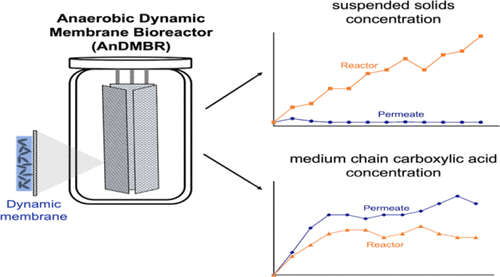当前位置:
X-MOL 学术
›
ACS ES&T Eng.
›
论文详情
Our official English website, www.x-mol.net, welcomes your
feedback! (Note: you will need to create a separate account there.)
Anaerobic Dynamic Membrane Bioreactor Development to Facilitate Organic Waste Conversion to Medium-Chain Carboxylic Acids and Their Downstream Recovery
ACS ES&T Engineering ( IF 7.4 ) Pub Date : 2021-12-16 , DOI: 10.1021/acsestengg.1c00273 Shilva Shrestha 1 , Siqi Xue 1 , Dianna Kitt 1 , Hang Song 1 , Caro Truyers 1, 2 , Maxim Muermans 1, 2 , Ilse Smets 2 , Lutgarde Raskin 1
ACS ES&T Engineering ( IF 7.4 ) Pub Date : 2021-12-16 , DOI: 10.1021/acsestengg.1c00273 Shilva Shrestha 1 , Siqi Xue 1 , Dianna Kitt 1 , Hang Song 1 , Caro Truyers 1, 2 , Maxim Muermans 1, 2 , Ilse Smets 2 , Lutgarde Raskin 1
Affiliation

|
Platform chemicals such as medium-chain carboxylic acids (MCCAs) can be produced from organic waste streams via chain elongation in anaerobic mixed-culture bioreactors. A product recovery system is needed to collect MCCAs from the bioreactor effluent. Membrane-based liquid–liquid extraction, the most commonly used product recovery approach, requires suspended solids removal from the bioreactor effluent to avoid membrane fouling. An anaerobic dynamic membrane bioreactor (AnDMBR) was developed to evaluate MCCA production from brewery and prefermented food waste and to produce a permeate with low suspended solids to facilitate downstream product recovery. The AnDMBR employed an inexpensive stainless-steel mesh as the support material for the development of a biofilm or dynamic membrane, which was responsible for solids–liquid separation. The AnDMBR produced a permeate quality with an average total suspended solids (TSS) concentration of 0.12 g L–1, while the average bioreactor TSS concentration was two orders of magnitude higher (21.6 g L–1). A maximum solids removal efficiency of ≥99% was achieved and good permeate quality was sustained for over 200 days without fouling control or cleaning the support material. In addition to solids–liquid separation, the dynamic membrane was responsible for a substantial fraction of the biological activity of the AnDMBR. The relative activity of Clostridiales, as determined by 16S rRNA sequencing, correlated with MCCA production and was higher in the dynamic membrane (20.0 ± 4.9%) than in the suspended biomass (5.2 ± 2.7%) in the bioreactor. This observation was consistent with MCCA production data as the permeate MCCA concentrations were significantly (p = 8.2 × 10–5) higher than that in the bioreactor, suggesting that the dynamic membrane biofilm contributed to chain elongation.
中文翻译:

开发厌氧动态膜生物反应器以促进有机废物转化为中链羧酸及其下游回收
中链羧酸 (MCCA) 等平台化学品可以通过厌氧混合培养生物反应器中的链延长从有机废物流中生产。需要一个产品回收系统来从生物反应器流出物中收集 MCCA。基于膜的液-液萃取是最常用的产品回收方法,需要从生物反应器流出物中去除悬浮固体以避免膜污染。开发了一种厌氧动态膜生物反应器 (AnDMBR) 来评估啤酒厂和改良食品垃圾中 MCCA 的生产,并生产具有低悬浮固体的渗透液,以促进下游产品的回收。AnDMBR 采用廉价的不锈钢网作为支撑材料,用于开发生物膜或动态膜,负责固液分离。–1,而平均生物反应器 TSS 浓度高出两个数量级(21.6 g L –1)。实现了 ≥99% 的最大固体去除效率,并且在 200 多天没有结垢控制或清洁支撑材料的情况下保持良好的渗透质量。除了固液分离之外,动态膜还负责 AnDMBR 的大部分生物活性。通过 16S rRNA 测序测定,梭状芽胞杆菌的相对活性与 MCCA 产生相关,并且在生物反应器中动态膜 (20.0 ± 4.9%) 高于悬浮生物质 (5.2 ± 2.7%)。这一观察结果与 MCCA 生产数据一致,因为渗透 MCCA 浓度显着(p= 8.2 × 10 –5 ) 比生物反应器中的高,表明动态膜生物膜有助于链伸长。
更新日期:2022-02-11
中文翻译:

开发厌氧动态膜生物反应器以促进有机废物转化为中链羧酸及其下游回收
中链羧酸 (MCCA) 等平台化学品可以通过厌氧混合培养生物反应器中的链延长从有机废物流中生产。需要一个产品回收系统来从生物反应器流出物中收集 MCCA。基于膜的液-液萃取是最常用的产品回收方法,需要从生物反应器流出物中去除悬浮固体以避免膜污染。开发了一种厌氧动态膜生物反应器 (AnDMBR) 来评估啤酒厂和改良食品垃圾中 MCCA 的生产,并生产具有低悬浮固体的渗透液,以促进下游产品的回收。AnDMBR 采用廉价的不锈钢网作为支撑材料,用于开发生物膜或动态膜,负责固液分离。–1,而平均生物反应器 TSS 浓度高出两个数量级(21.6 g L –1)。实现了 ≥99% 的最大固体去除效率,并且在 200 多天没有结垢控制或清洁支撑材料的情况下保持良好的渗透质量。除了固液分离之外,动态膜还负责 AnDMBR 的大部分生物活性。通过 16S rRNA 测序测定,梭状芽胞杆菌的相对活性与 MCCA 产生相关,并且在生物反应器中动态膜 (20.0 ± 4.9%) 高于悬浮生物质 (5.2 ± 2.7%)。这一观察结果与 MCCA 生产数据一致,因为渗透 MCCA 浓度显着(p= 8.2 × 10 –5 ) 比生物反应器中的高,表明动态膜生物膜有助于链伸长。











































 京公网安备 11010802027423号
京公网安备 11010802027423号